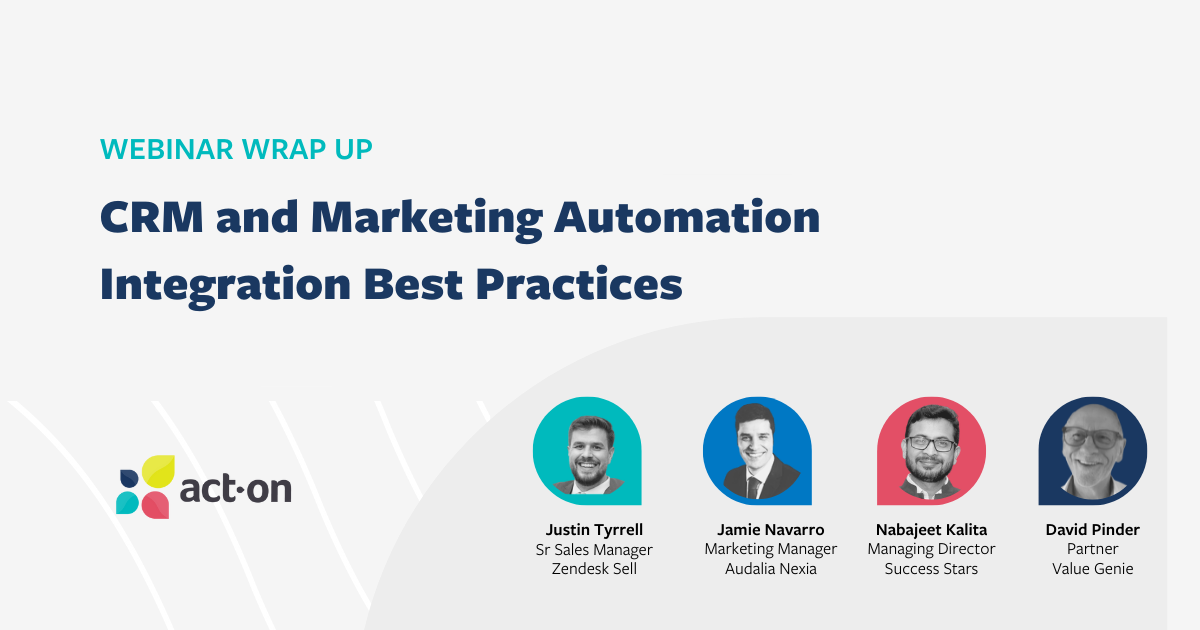WEBINAR WRAP-UP
The overwhelming majority of business leaders agree: collaboration between sales and marketing enables critical growth.
This is true for teams, and for technology. When you use your CRM and marketing automation tools together, you unlock the potential to convert more leads, drive higher sales, and deliver more seamless customer experiences.
But integrating these platforms can be a challenge for many companies. So in our recent webinar, experts in marketing, sales, customer success, and data strategy from Success Stars, Value Genie, Audalia Nexia, and Zendesk Sell sat down to explore what it actually looks like when your CRM and marketing automation platform are fully integrated. These leaders have seen firsthand that when businesses create a bidirectional, unified system of data that’s shared between marketing and sales, alignment and collaboration becomes much simpler.
Read on for our experts’ key takeaways on how CRM and marketing automation work together to put consistent messaging, more resonant content, better targeting, and improved outcomes within your reach.
Takeaway 1: Put Customer Relationships at the Center
David Pinder, partner at Value Genie, admits to feeling jaded about the term CRMs, because they are more commonly used to facilitate customer transactions than actually build customer relationships. But he believes that in today’s fully evolved digital world, relationships are what will make all the difference.
For users on the other end of CRM communications, though, those relationships are often made up of interactions with different voices across the sales, marketing, and CX teams. And that has to change.
Takeaway 2: Talk to the Customer
David sees a gap: customers are never buying what the supplier is selling. And it’s not that the product is misaligned with the audience. It’s that the customer is searching for and buying a different outcome than what your sales team may be focusing on.
His advice? Talk to your existing customers (or get somebody else to do it for you) to discover the real, underlying drivers in their buying decisions. Get to a point of understanding about what those important outcomes are so you can sell what your customers are buying.
Takeaway 3: Enable Shared Data Analysis
Nabajeet Kalita, founder of Success Stars, always advises his clients that the data sync between marketing automation and CRM platforms needs to be bidirectional.
Marketing automation captures data on customer behavior across channels to gain insights into what messages or experiences resonate. And while it’s important to use that data to optimize campaigns, Nabajeet believes it’s equally important that this data gets passed along to the CRM and the sales team so they can act upon it when working with leads.
And the best time to implement this data strategy? Yesterday.
Takeaway 4: Find the Right Customer
To Justin Tyrrell, sales leader at Zendesk Sell, it all comes down to this: customers will only sign up if your product is the right product for them. So the most crucial step is finding the right customers.
When you do so, you can personalize your outreach because you know who the business is and what they do. You can create good nurturing because you know what they want. And your sales team can integrate better with marketing to reach them with the right content, because you’re all in agreement about who the right customers are. Everything else falls into place.
Takeaway 5: Be Open to Multiple Solutions
Justin sees companies fall into a trap of believing that they need to buy one solution that does everything. And inevitably, that means someone is making a sacrifice.
Usually, it means one or more teams don’t get the right solution for them. Maybe the sales team gets a functionally brilliant but overly complex solution. Or maybe marketing gets a tool that doesn’t actually do everything they need.
Instead, he advises leaders to look for solutions that can integrate with one another. Find the right tech for marketing, find the right tech for sales, find the right tech for other teams, and figure out if they can talk to each other. Multiple tools that integrate together can solve more problems than a single “solution” that doesn’t quite do it all.
Takeaway 6: How the Puzzle Pieces Come Together
For Nabajeet, finding the right tech solution starts with understanding your specific business problems or goals. He advises clients to start by defining their key objectives, which can be different for different companies. Some teams may be focused on generating leads, while others need to provide consistent messaging across channels. Once you know your business problem, then you can find the tool that will best solve it.
And finally, he recommends developing an implementation strategy that allows you to work on each piece of the puzzle without losing sight of your big-picture goals. Because when you integrate your CRM and marketing automation platform with an outcome-driven approach, you solve meaningful problems and provide better visibility for marketing and sales along every stage of the buyer’s journey.
More Insights from our Expert Panel
Ready for more insights from these sales and marketing experts? Watch the full recording for actionable tips, real-life examples of how CRM and marketing automation should work together, and practical ways to get started.
